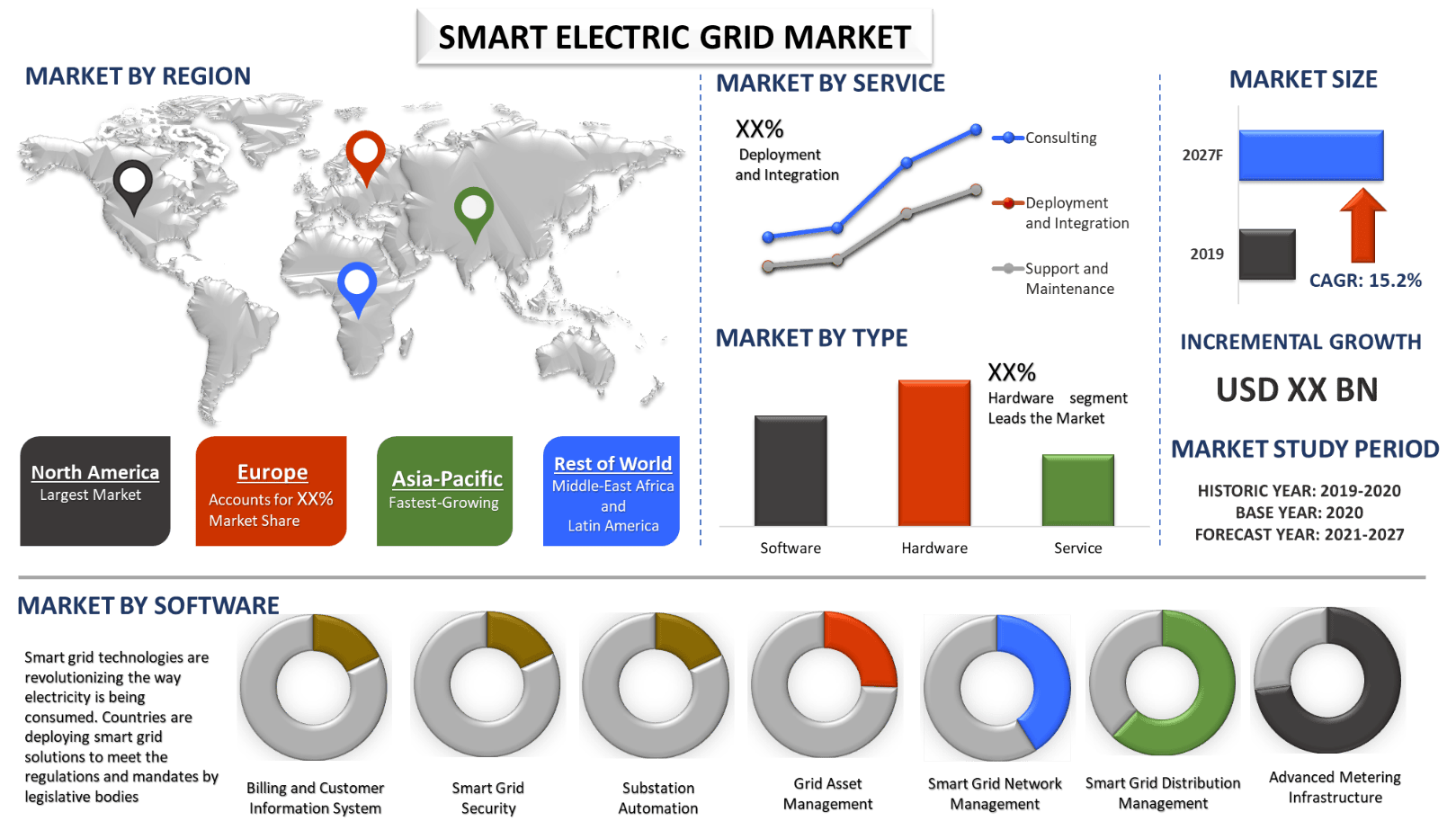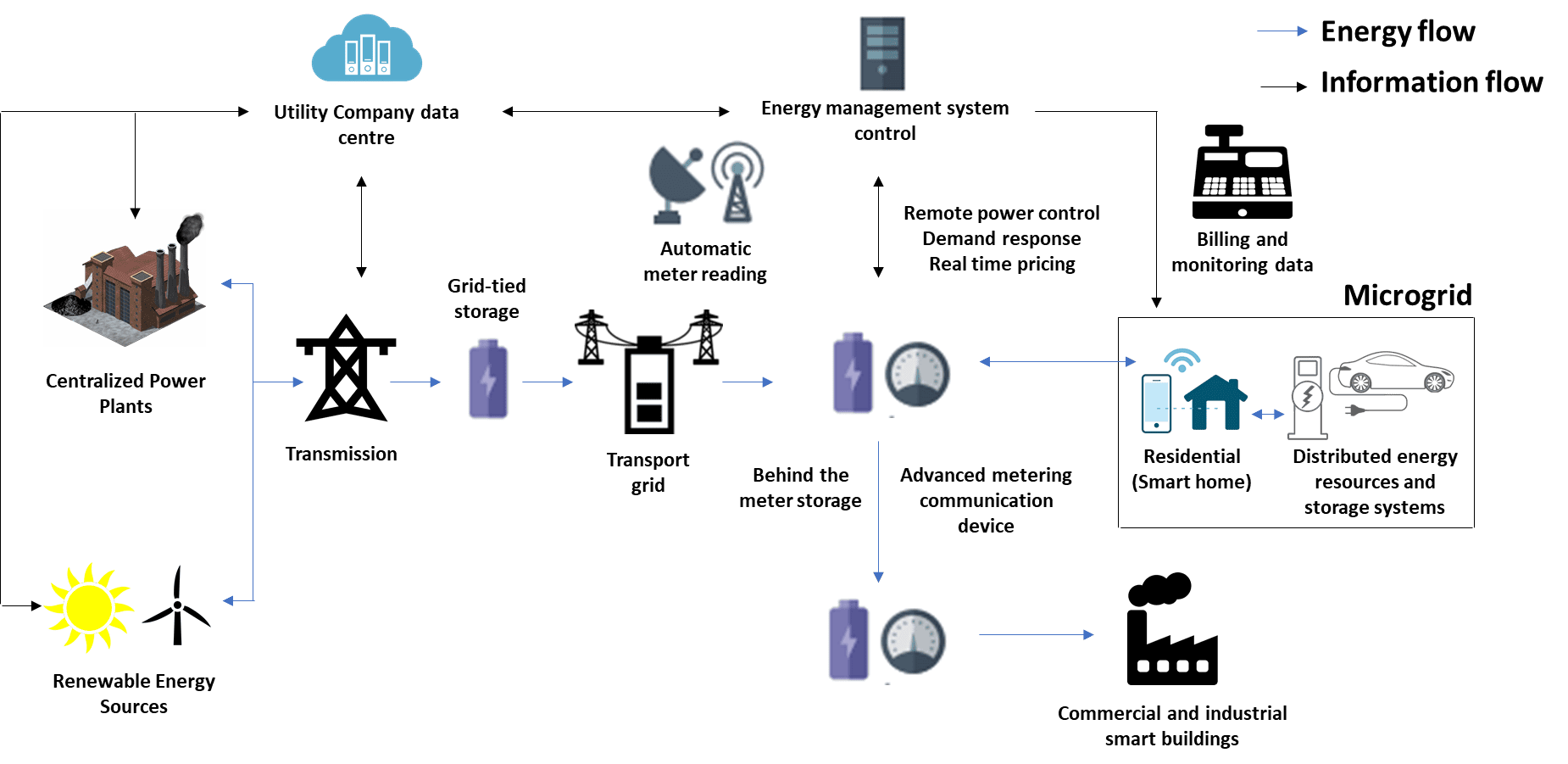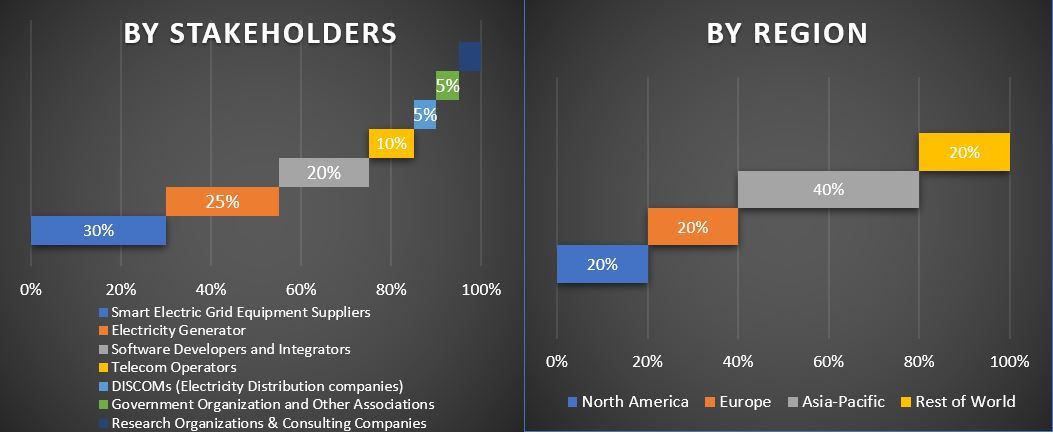- Trang chủ
- Về chúng tôi
- Ngành
- Dịch vụ
- Đọc
- Liên hệ với chúng tôi
Thị trường Lưới điện Thông minh: Phân tích Hiện tại và Dự báo (2021-2027)
Nhấn mạnh vào Thành phần (Phần mềm, Phần cứng, Dịch vụ); Phần mềm (Cơ sở hạ tầng đo đếm thông minh, Quản lý phân phối lưới điện thông minh, Quản lý mạng lưới điện thông minh, Quản lý tài sản lưới điện, Tự động hóa trạm biến áp, An ninh lưới điện thông minh, Hệ thống thông tin khách hàng và thanh toán); Phần cứng (Cảm biến, Bộ điều khiển logic khả trình, Đồng hồ thông minh, Phần cứng mạng); Dịch vụ (Tư vấn, Triển khai và tích hợp, Hỗ trợ và bảo trì); Khu vực và Quốc gia

Thị trường giải pháp Lưới điện thông minh toàn cầu dự kiến đạt giá trị thị trường 98,9 tỷ đô la Mỹ vào năm 2027, chứng kiến mức tăng trưởng CAGR là 15,2% trong giai đoạn dự báo 2021-2027. Theo Northeast Group, lưới điện thông minh là một lưới điện được tích hợp đầy đủ với ICT (công nghệ thông tin và truyền thông). Các công cụ này và các ứng dụng khác cung cấp năng lượng cho cả công ty tiện ích và khách hàng cuối với các phân tích và kiểm soát được cải thiện đối với dòng điện và việc sử dụng, để tối ưu hóa nguồn cung và nhu cầu tốt hơn. Trên toàn cầu, đầu tư vào hệ thống lưới điện thông minh đã giảm trong năm thứ 3 liên tiếp trong năm tài chính 2019, chứng kiến mức giảm 7%, so với giá trị năm 2018. Năm 2019, tổng vốn đầu tư đạt 271 tỷ đô la Mỹ, so với 294 tỷ đô la Mỹ năm 2018. Ngoài ra, đầu tư cho bộ công nghệ kỹ thuật số đầy đủ, bao gồm cơ sở hạ tầng đo đếm tiên tiến, tự động hóa tiện ích và cơ sở hạ tầng sạc EV, chiếm hơn 15% tổng chi tiêu cho lưới điện thông minh toàn cầu vào năm 2019. Hơn nữa, vào năm 2019, đầu tư vào các giải pháp lưới điện thông minh của Hoa Kỳ đã vượt qua Trung Quốc lần đầu tiên sau 10 năm. Đầu tư của Hoa Kỳ vào lưới điện thông minh đã chứng kiến mức tăng 12% vào năm 2019, so với năm 2018.
Thiết kế hệ thống mẫu và kết nối liên thông của Lưới điện thông minh

Đại dịch Covid-19 đã tác động đến tất cả các thành phần của xã hội và ngành công nghiệp, và thị trường Lưới điện thông minh cũng không ngoại lệ. Việc tạm hoãn lắp đặt đồng hồ đo do Covid-19 đã có tác động tiêu cực nhỏ đến mức vận chuyển trong năm 2020, đồng thời tổng số Lưới điện thông minh được lắp đặt vào năm 2020 cũng giảm 10% so với năm trước đó là năm 2019. Số lượng đồng hồ đo điện thông minh hàng năm đạt 20,9 triệu chiếc vào năm 2019 và con số tương ứng cho Đồng hồ đo khí thông minh là 8,5 triệu chiếc.
Thông tin chi tiết được trình bày trong Báo cáo
“Trong số các thành phần, phân khúc Phần cứng chiếm lĩnh thị trường vào năm 2020.”
Dựa trên thành phần, thị trường Lưới điện thông minh toàn cầu được chia thành phần mềm, Phần cứng, Dịch vụ. Hiện tại, phân khúc phần cứng chiếm lĩnh thị trường. Đầu tư vào lưới điện thông minh vẫn tập trung vào phần cứng, từ các trạm biến áp kỹ thuật số đến đo đếm thông minh và các thiết bị kỹ thuật điện khác. Tuy nhiên, các công ty tiện ích trên toàn thế giới đã chỉ ra rằng họ ngày càng áp dụng các công cụ phần mềm phức tạp để theo dõi và phân phối điện tốt hơn.
“Trong số các Phần mềm, phân khúc quản lý phân phối lưới điện thông minh sẽ chứng kiến mức tăng trưởng cao nhất”
Dựa trên phần mềm, thị trường được chia thành Cơ sở hạ tầng đo đếm tiên tiến, Quản lý phân phối lưới điện thông minh, Quản lý mạng lưới điện thông minh, Quản lý tài sản lưới điện, Tự động hóa trạm biến áp, Bảo mật lưới điện thông minh, Hệ thống thông tin khách hàng và thanh toán. Theo EIA, các công ty điện lực Hoa Kỳ đã lắp đặt hơn 94,8 triệu cơ sở hạ tầng đo đếm tiên tiến (AMI) tính đến năm 2019.
“Trong số các Phần cứng, Đồng hồ đo thông minh sẽ chứng kiến sự tăng trưởng vượt bậc”
Dựa trên phần cứng, thị trường được chia thành Cảm biến, Bộ điều khiển logic lập trình, Đồng hồ đo thông minh, Phần cứng mạng. Châu Âu đã nổi lên như một trung tâm lớn về đồng hồ đo thông minh, mang lại nhiều cơ hội tăng trưởng cho các nhà sản xuất, vì đo đếm thông minh là bắt buộc ở Vương quốc Anh và trên khắp Châu Âu. Năm 2018, trên toàn cầu, số lượng đồng hồ đo điện, khí đốt và nước thông minh đã lắp đặt là 1.190 triệu và con số này dự kiến sẽ đạt 1.645 triệu vào cuối năm 2020.
“Trong số các Dịch vụ, phân khúc Triển khai và Tích hợp sẽ chứng kiến mức tăng trưởng cao”
Dựa trên Dịch vụ, thị trường được chia thành Tư vấn, Triển khai và Tích hợp, Hỗ trợ và Bảo trì. Các dịch vụ giúp vượt qua nhiều thách thức kinh doanh, tạo ra các cơ hội tăng trưởng cao và thúc đẩy các đổi mới công nghệ trong lĩnh vực năng lượng. Ví dụ: vào năm 2019, Schneider Electric đã công bố mở rộng hoạt động kinh doanh tại Brazil, với việc khai trương trung tâm phân phối thông minh ở nước này.
“Bắc Mỹ đại diện cho các thị trường lớn nhất trong Thị trường Lưới điện thông minh Toàn cầu.”
Để hiểu rõ hơn về việc chấp nhận thị trường, báo cáo cung cấp phân tích chi tiết cho các khu vực và quốc gia lớn bao gồm Bắc Mỹ (Hoa Kỳ, Canada, Phần còn lại của Bắc Mỹ), Châu Âu (Đức, Vương quốc Anh, Pháp, Tây Ban Nha, Phần còn lại của Châu Âu), Châu Á-Thái Bình Dương (Trung Quốc, Nhật Bản, Ấn Độ, Úc, Phần còn lại của APAC), MEA (Ả Rập Saudi, UAE, Nam Phi, Phần còn lại của MEA), Châu Mỹ Latinh (Brazil, Argentina, Phần còn lại của Châu Mỹ Latinh). Năm 2020, Bắc Mỹ thống trị thị trường, tuy nhiên, sau năm 2022, Châu Á-Thái Bình Dương dự kiến sẽ vượt qua Bắc Mỹ để trở thành thị trường lớn nhất về các giải pháp Lưới điện thông minh. Hơn nữa, trong giai đoạn dự báo, các thị trường mới nổi ở khu vực MEA ước tính sẽ đi đầu trong việc triển khai Lưới điện thông minh như một nguồn cung cấp và quản lý năng lượng đáng tin cậy. Một số công ty lớn hoạt động trên thị trường bao gồm Honeywell International, Schneider Electric SE, Duke Energy Corporation, General Electric Company, ABB Limited, Siemens AG, IBM Corporation, Hitachi, Ltd., Landis+Gyr, Itron.
Lý do nên mua báo cáo này:
- Nghiên cứu bao gồm phân tích kích thước thị trường và dự báo được xác thực bởi các chuyên gia hàng đầu trong ngành đã được xác thực
- Báo cáo trình bày một đánh giá nhanh về hiệu suất tổng thể của ngành trong nháy mắt
- Báo cáo bao gồm phân tích chuyên sâu về các đồng nghiệp nổi bật trong ngành với trọng tâm chính là tài chính kinh doanh chính, danh mục sản phẩm, chiến lược mở rộng và các phát triển gần đây
- Kiểm tra chi tiết các động lực, hạn chế, xu hướng chính và cơ hội hiện hành trong ngành
- Nghiên cứu bao quát toàn diện thị trường trên các phân khúc khác nhau
- Phân tích sâu cấp quốc gia về ngành
Tùy chọn tùy chỉnh:
Thị trường Lưới điện thông minh Toàn cầu có thể được tùy chỉnh thêm theo yêu cầu hoặc bất kỳ phân khúc thị trường nào khác. Bên cạnh đó, UMI hiểu rằng bạn có thể có nhu cầu kinh doanh riêng, do đó, vui lòng liên hệ với chúng tôi để nhận được một báo cáo hoàn toàn phù hợp với yêu cầu của bạn.
Mục lục
Phân tích thị trường lịch sử, ước tính thị trường hiện tại và dự báo tương lai của Thị trường Lưới điện Thông minh Toàn cầu là ba bước chính được thực hiện để tạo và phân tích việc áp dụng các giải pháp Lưới điện Thông minh trên toàn cầu. Nghiên cứu thứ cấp toàn diện đã được thực hiện để thu thập số liệu thị trường lịch sử và ước tính quy mô thị trường hiện tại. Thứ hai, để xác thực những hiểu biết sâu sắc này, nhiều phát hiện và giả định đã được xem xét. Hơn nữa, các cuộc phỏng vấn sơ cấp toàn diện cũng được thực hiện với các chuyên gia trong ngành trên toàn bộ chuỗi giá trị của ngành Lưới điện Thông minh toàn cầu. Sau khi giả định và xác thực số liệu thị trường thông qua các cuộc phỏng vấn sơ cấp, chúng tôi đã sử dụng phương pháp tiếp cận từ dưới lên để dự báo quy mô thị trường hoàn chỉnh. Sau đó, các phương pháp phân tích dữ liệu và phân tích tam giác đã được áp dụng để ước tính và phân tích quy mô thị trường của các phân khúc và phân khúc phụ mà ngành liên quan đến. Phương pháp luận chi tiết được giải thích dưới đây:
Phân tích Quy mô Thị trường Lịch sử
Bước 1: Nghiên cứu Chuyên sâu về các Nguồn Thứ cấp:
Nghiên cứu thứ cấp chi tiết đã được thực hiện để có được quy mô thị trường lịch sử của Lưới điện Thông minh thông qua các nguồn nội bộ của công ty như báo cáo thường niên & báo cáo tài chính, các bài thuyết trình về hiệu suất, thông cáo báo chí, v.v., và các nguồn bên ngoài bao gồm tạp chí, tin tức & bài viết, ấn phẩm của chính phủ, ấn phẩm của đối thủ cạnh tranh, báo cáo ngành, cơ sở dữ liệu của bên thứ ba và các ấn phẩm đáng tin cậy khác.
Bước 2: Phân khúc Thị trường:
Sau khi có được quy mô thị trường lịch sử của thị trường Lưới điện Thông minh, chúng tôi đã tiến hành phân tích thứ cấp chi tiết để thu thập thông tin chi tiết về thị trường lịch sử và chia sẻ cho các phân khúc & phân khúc phụ khác nhau cho các khu vực chính. Các phân khúc chính được bao gồm trong báo cáo như thành phần, phần mềm, phần cứng, dịch vụ. Phân tích sâu hơn ở cấp khu vực và quốc gia đã được tiến hành để đánh giá việc áp dụng tổng thể Lưới điện Thông minh trên toàn cầu.
Bước 3: Phân tích Yếu tố:
Sau khi có được quy mô thị trường lịch sử của các phân khúc và phân khúc phụ khác nhau, chúng tôi đã tiến hành phân tích yếu tố chi tiết để ước tính quy mô thị trường hiện tại của Lưới điện Thông minh. Hơn nữa, chúng tôi đã tiến hành phân tích yếu tố bằng cách sử dụng các biến phụ thuộc và độc lập như sự tăng trưởng của việc thâm nhập các giải pháp Lưới điện Thông minh trên các quốc gia lớn, số hóa ngành điện, v.v. Một phân tích kỹ lưỡng đã được thực hiện cho kịch bản cung và cầu xem xét các quan hệ đối tác hàng đầu, sáp nhập và mua lại, mở rộng kinh doanh và ra mắt sản phẩm trong ngành Lưới điện Thông minh.
Ước tính & Dự báo Quy mô Thị trường Hiện tại
Định cỡ Thị trường Hiện tại: Dựa trên những hiểu biết sâu sắc có thể hành động từ 3 bước trên, chúng tôi đã đạt được quy mô thị trường hiện tại, những người chơi chính trong thị trường Lưới điện Thông minh Toàn cầu và thị phần của các phân khúc. Tất cả các phần trăm chia sẻ bắt buộc và phân tích thị trường đã được xác định bằng cách sử dụng phương pháp thứ cấp đã nói ở trên và đã được xác minh thông qua các cuộc phỏng vấn sơ cấp.
Ước tính & Dự báo: Đối với ước tính và dự báo thị trường, trọng số đã được gán cho các yếu tố khác nhau bao gồm các động lực & xu hướng, hạn chế và cơ hội có sẵn cho các bên liên quan. Sau khi phân tích các yếu tố này, các kỹ thuật dự báo có liên quan, tức là phương pháp tiếp cận từ dưới lên đã được áp dụng để đạt được dự báo thị trường đến năm 2027 cho các phân khúc và phân khúc phụ khác nhau trên các khu vực chính trên toàn cầu. Phương pháp nghiên cứu được áp dụng để ước tính quy mô thị trường bao gồm:
- Quy mô thị trường của ngành, về giá trị (US$) và tỷ lệ chấp nhận Lưới điện Thông minh trên các thị trường lớn
- Tất cả các phần trăm chia sẻ, phân tích và phân tách các phân khúc và phân khúc phụ của thị trường
- Những người chơi chính trong thị trường Lưới điện Thông minh về các dịch vụ được cung cấp. Ngoài ra, các chiến lược tăng trưởng được áp dụng bởi những người chơi này để cạnh tranh trong thị trường đang phát triển nhanh chóng.
Xác thực Quy mô và Thị phần
Nghiên cứu Sơ cấp: Các cuộc phỏng vấn chuyên sâu đã được thực hiện với các Nhà lãnh đạo Ý kiến Chủ chốt (KOL) bao gồm các Giám đốc Điều hành Cấp cao nhất (CXO/VP, Trưởng phòng Kinh doanh, Trưởng phòng Tiếp thị, Trưởng phòng Vận hành và Trưởng phòng Khu vực, Trưởng phòng Quốc gia, v.v.) trên khắp các khu vực chính. Các phát hiện nghiên cứu sơ cấp sau đó đã được tóm tắt và phân tích thống kê đã được thực hiện để chứng minh giả thuyết đã nêu. Thông tin đầu vào từ nghiên cứu sơ cấp đã được hợp nhất với các phát hiện thứ cấp, do đó biến thông tin thành những hiểu biết sâu sắc có thể hành động.
Phân chia Người tham gia Sơ cấp ở các Khu vực Khác nhau
Kỹ thuật Thị trường
Kỹ thuật phân tích dữ liệu tam giác đã được sử dụng để hoàn thành ước tính thị trường tổng thể và đạt được số liệu thống kê chính xác của từng phân khúc và phân khúc phụ của thị trường Lưới điện Thông minh Toàn cầu. Dữ liệu được chia thành nhiều phân khúc & phân khúc phụ sau khi nghiên cứu các thông số và xu hướng khác nhau trong các lĩnh vực thành phần, phần mềm, phần cứng, dịch vụ.
Mục tiêu chính của Nghiên cứu Thị trường Lưới điện Thông minh
Các xu hướng thị trường hiện tại & tương lai của Lưới điện Thông minh Toàn cầu đã được xác định rõ trong nghiên cứu. Các nhà đầu tư có thể có được những hiểu biết sâu sắc về chiến lược để dựa vào quyết định của họ cho các khoản đầu tư từ phân tích định tính và định lượng được thực hiện trong nghiên cứu. Các xu hướng thị trường hiện tại và tương lai đã được xác định mức độ hấp dẫn tổng thể của thị trường ở cấp quốc gia, cung cấp một nền tảng cho người tham gia công nghiệp khai thác thị trường chưa được khai thác để hưởng lợi như một lợi thế của người đi đầu. Các mục tiêu định lượng khác của các nghiên cứu bao gồm:
- Phân tích quy mô thị trường hiện tại và dự báo của Lưới điện Thông minh về giá trị (US$). Ngoài ra, phân tích quy mô thị trường hiện tại và dự báo của các phân khúc và phân khúc phụ khác nhau
- Các phân khúc trong nghiên cứu bao gồm các lĩnh vực thành phần, phần mềm, phần cứng, dịch vụ
- Phân tích xác định về khung pháp lý cho ngành Lưới điện Thông minh
- Phân tích chuỗi giá trị liên quan đến sự hiện diện của các trung gian khác nhau, cùng với việc phân tích hành vi của khách hàng và đối thủ cạnh tranh của ngành
- Phân tích quy mô thị trường hiện tại và dự báo của Lưới điện Thông minh cho các quốc gia lớn
- Các khu vực/quốc gia lớn được phân tích trong báo cáo bao gồm Bắc Mỹ (Hoa Kỳ, Canada, Phần còn lại của Bắc Mỹ), Châu Âu (Đức, Anh, Pháp, Tây Ban Nha, Phần còn lại của Châu Âu), Châu Á-Thái Bình Dương (Trung Quốc, Nhật Bản, Ấn Độ, Úc, Phần còn lại của Châu Á-Thái Bình Dương), Trung Đông và Châu Phi (Ả Rập Xê Út, UAE, Nam Phi, Phần còn lại của MEA), Châu Mỹ Latinh (Brazil, Argentina, Phần còn lại của Châu Mỹ Latinh)
- Hồ sơ công ty của những người chơi thị trường Lưới điện Thông minh và các chiến lược tăng trưởng được họ áp dụng để duy trì trong thị trường đang phát triển nhanh chóng
- Phân tích chuyên sâu ở cấp quốc gia của ngành
Liên quan Báo cáo
Khách hàng đã mua mặt hàng này cũng đã mua











